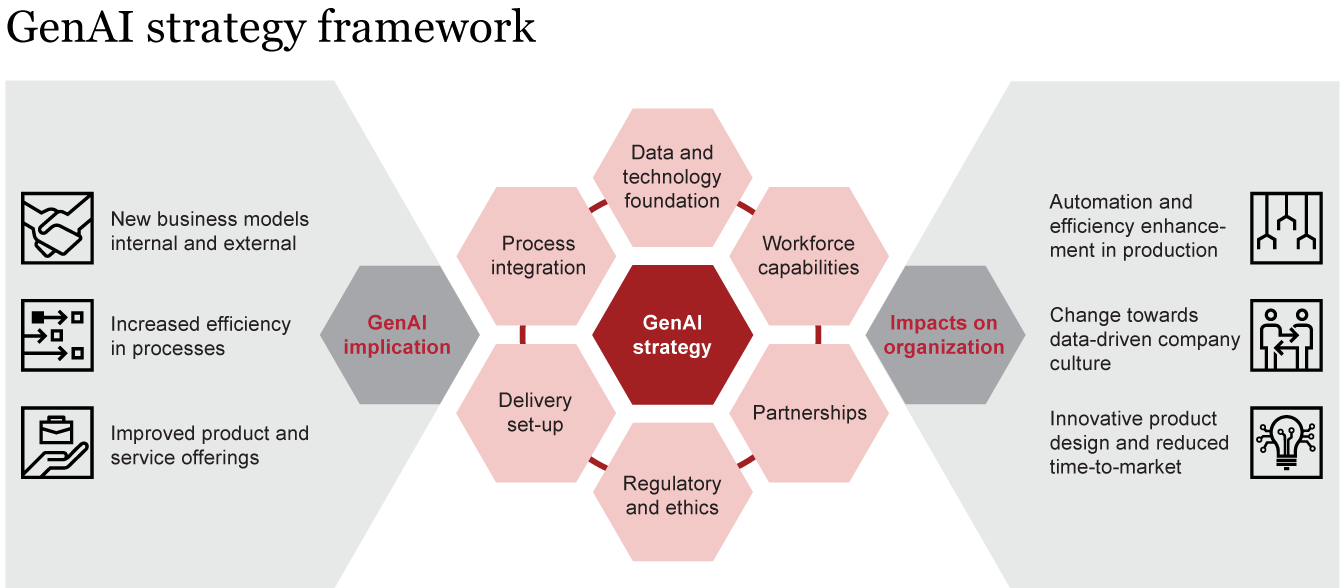Unlocking the potential of GenAI in industrial manufacturing
Generative artificial intelligence (GenAI) is revolutionizing digital transformation, emerging as a key driver of innovation and competitive advantage in industrial manufacturing. With its vast potential, GenAI is set to transform the industry, offering solutions that range from streamlining development processes and providing predictive maintenance insights to conducting complex data analyses for strategic decision-making. As GenAI technology continues to evolve, manufacturers are better equipped to adapt to market changes and enhance their competitive positioning.
To analyze how GenAI can significantly enhance profitability, Strategy& has collaborated with VDMA, the largest machinery and equipment manufacturing industry association in Germany and Europe, on an in-depth study. This extensive research examines 45 potential GenAI applications and gathers insights from a survey of 247 industrial manufacturing companies across Germany, Austria, and Switzerland. The study addresses crucial aspects such as the current and future impact of GenAI innovations, the evolution of essential skill sets, workplace transformation, and the potential for groundbreaking business models within a value-driven manufacturing landscape.
Revitalizing industrial manufacturing: A path to prosperity
Over the past five years, industrial manufacturing in Germany, Austria, and Switzerland has faced a challenging landscape. As gross profits have declined, costs have surged, and productivity growth has slowed. This downturn has impacted a wide range of sectors, including automotive, machinery, and automation technology.
Historically, industrial manufacturers have boosted productivity and profitability through organizational and technological innovations. The introduction of lean manufacturing and enterprise-wide resource planning systems revolutionized the industry, leading to a remarkable productivity increase of over 30% between 1990 and 2002. The subsequent decade saw a similar surge due to advancements in automation and robotics.
Yet, the transition to Smart Manufacturing and Industry 4.0 has not been without hurdles. Many companies are striving to strike the right balance between investment and measurable returns on revenue and profitability, resulting in mixed outcomes. Since 2015, productivity per employee has seen minimal improvement, with only a 5% rise since 2010. As the industry navigates these challenges, leveraging cutting-edge technologies like generative artificial intelligence could offer a new pathway to revitalization and growth.
Crafting a GenAI strategy for industrial success
Reflecting on the past, various technological innovations have been tested, offering valuable insights into their potential. Now it is time to consolidate these lessons and devise a focused, top-down strategy for implementing GenAI. Like previous technological trends, GenAI faces its own set of challenges and investment barriers. Our survey identifies the top three obstacles as:
- 1Insufficient data and poor data quality
- 2A shortage of specialized skills and training opportunities
- 3Inadequate IT infrastructure and software sophistication
To navigate these challenges and overcome investment barriers, it is essential to first understand and then address these roadblocks. A strategic, top-down approach to GenAI, with clear objectives, is essential. This strategy should outline a vision for how GenAI will transform the future operating model, from incremental improvements to disruptive changes.
Establishing a governance framework will help ensure compliance with regulations and ethical standards in GenAI. Additionally, creating an incubator can provide the necessary guidance and power for effective and efficient implementation of use cases. Building strong partnerships will expedite the development of essential workforce capabilities.
A strategic blueprint for GenAI success
To infuse structure and value-driven thinking into companies' GenAI implementation programs, we employ a strategic approach that unfolds in three distinct stages, fostering a comprehensive understanding of GenAI's role in business:
- 1Craft a top-down vision:
Develop a clear strategy that outlines your goals, defines your ambition level, and sets targets for both top-line and bottom-line enhancements. Engage and align with stakeholders to ensure a cohesive vision. - 2Establish an AI incubator framework:
Determine the purpose, scope, and methodology for how the incubator will assess and select GenAI use cases. This framework should guide the launch of impactful initiatives. - 3Monitor and manage implementation for optimal impact:
Initiate projects, regularly assess progress, discontinue underperforming initiatives, and expand successful strategies on a larger scale.
The GenAI incubator: A catalyst for tangible growth
To effectively navigate GenAI implementation challenges and realize substantial value, establishing a GenAI incubator is crucial. This organizational structure serves as a powerhouse for rapid innovation, attracting top talent and expediting time-to-market for industrial manufacturing companies. Our meticulously crafted framework supports the design and operation of a GenAI incubator, addressing the unique challenges manufacturers face in developing and executing their GenAI strategies. The framework is built around three pivotal questions, ensuring a focused and actionable approach to strategy implementation:

A three-stage journey to maximize ROI
While achieving financial targets and delivering a return on investment is undoubtedly crucial, evolving, testing, and selecting GenAI use cases require a period of open-ended experimentation. Only through this exploratory phase substantial returns on investment can be realized:
Stage one
Evolution
The journey begins by accelerating initial adoption, fostering innovation by reducing management constraints, and providing resources for experimentation without immediate financial targets
Stage two
Implementation
Successful ideas are then organized for large-scale delivery, where prototypes are expanded, employees receive upskilling, and pilot projects are executed
Stage three
Optimization
This phase ensures sustained return on investment by rigorously monitoring key performance indicators (KPIs), refining and standardizing processes, and scaling impactful use cases while eliminating underperformers
Navigating the future
Across the industry, companies face the daunting task of choosing from a vast array of technological options while keeping profitability improvement at the forefront. Common struggles include an overload of choices, mismatched use cases to profitability potential, and complex decisions about identifying, accelerating, and evaluating the most promising technologies.
We believe the solution lies in maintaining a clear vision for GenAI, establishing structures to facilitate accelerated implementation, being intolerant of obstacles, and having the courage to act differently, even if it means stepping outside the standard corporate playbook.
Leon Rupp, Dr. Thomas Wolf, Tobias Bleymehl, Aileen Goth, Rune Hiort, Tim Theis, Nils Breuer, and Svenja Matt have co-authored this report.
Contact us





